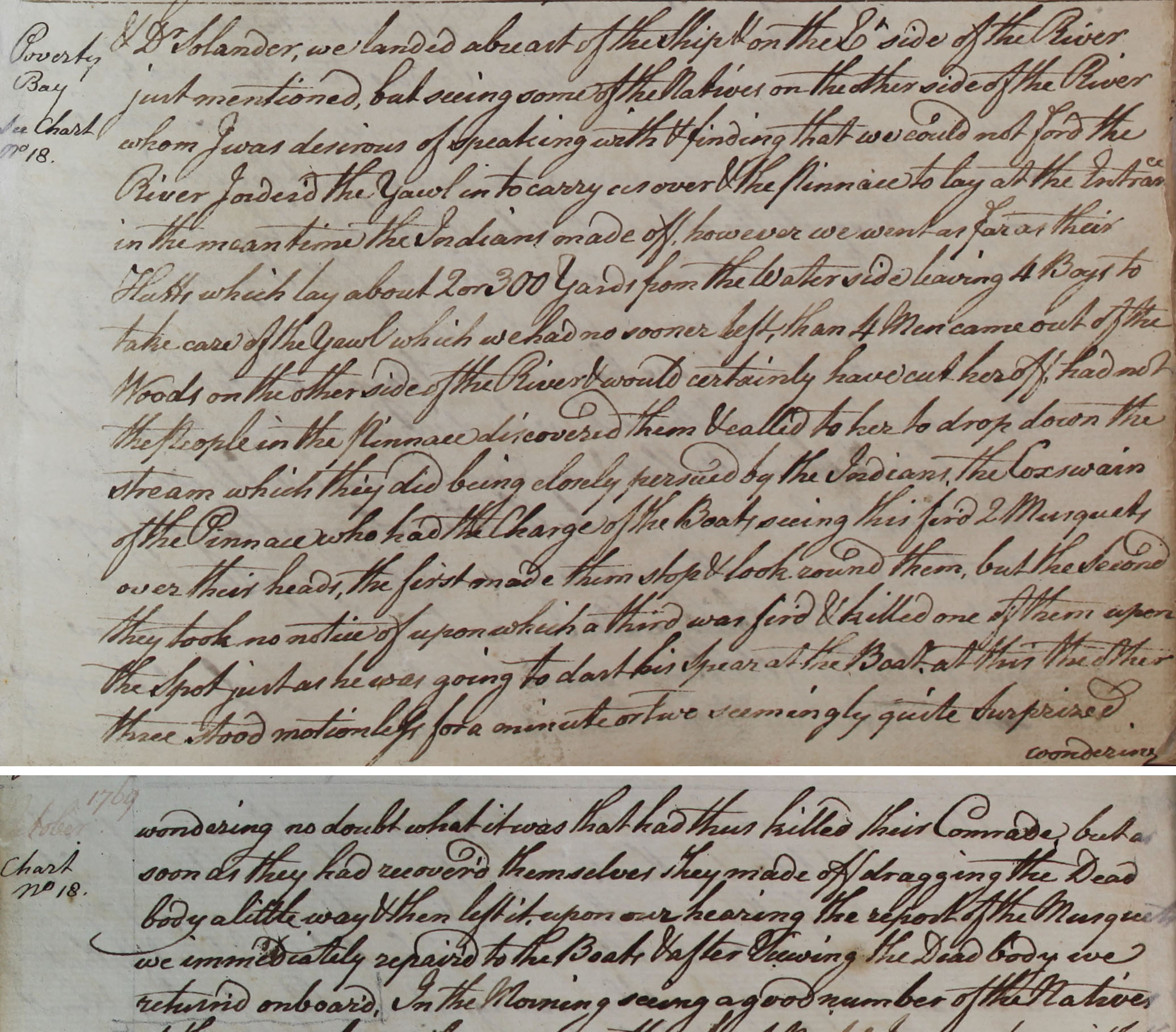
ENDEAVOUR: official copy of journal kept by Captain James Cook. Voyage of discovery, South Indian Ocean. 1768 May 27-1771 July 10. Catalogue ref: ADM 55/40.
Transcript
‘…we landed abreast of the ship on the East side of the River just mentioned, but seeing some of the Natives on the other side of the River whom I was desirous of speaking with and finding that we could not ford the River forded the Yawl [small boat] in to carry us over & the Pinnace [small boat] to lay at the entrance [of the river]. In the meantime the Indians made off, however we went as far as their Hutts which lay about 2 or 300 yards from the water side leaving 4 boys to take care of the Yawl which we had no sooner left, than 4 men came out of the woods on the other side of the River and would certainly have cut her off, had not the people in the Pinnace discovered them & called to her to drop down the stream which they did being closely pursued by the Indians. The Coxswain [in charge of navigation and steering] of the Pinnace who had the Charge of the Boats, seeing this fired two Musquets [long guns] over their heads, the first made them stop & look round them, but the Second they took no notice of upon which a third was fired & killed one of them upon the spot just as he was going to dart his spear at the Boat. At this the other three stood motionless for a minute or two seemingly quite surprised, wondering no doubt what it was that had killed their Comrade, but as soon as they had recover’d themselves their made off dragging the Dead body a little way and then left it. Upon overhearing the report of the Musquets we immediately repair’d to the Boats & after viewing the Dead body we return’d onboard. …’
Simplified transcript
‘…we landed alongside the ship on the east side of the river I just mentioned, but seeing some of the natives on the other side, who I wanted to speak with, and finding that we could not cross the river, we brought the yawl [small boat] to carry us over and the pinnace [another small boat] to lay at the entrance [of the river]. In the meantime the Indians took off; however, we went as far as their huts, which lay about 2 or 300 yards from the water, leaving 4 boys to take care of the small boat.
As soon as we had left it, 4 men came out of the woods on the other side of the river and would certainly have cut the pinnace off, if the people in the pinnace had not discovered them and decided to move downstream, which they did while closely pursued by the Indians. The coxswain [in charge of navigation and steering] of the pinnace, who was in charge of the boat, saw this and fired two muskets [long guns] over their heads. The first made them stop and look around, but they didn’t notice the second, after which a third was fired and killed one of them on the spot just as he was going to throw his spear at the Boat.
At this, the other three stood motionless for a minute or two, seemingly quite surprised, wondering no doubt what it was that had killed their comrade, but as soon as they had recovered they took off, dragging the dead body a little bit and then left it. On hearing the sound of the muskets we immediately returned to the boats and after viewing the dead body we returned on board. …’
Source 3
- How is it written, and on what material? What does this tell you about it, before you start reading it?
- Why do you think Cook’s coxswain [person who steers a ship’s boat] starts firing at the Māori?
- Look again at the second-to-last paragraph of Source 1. How does this paragraph portray Indigenous peoples? How might these instructions and attitudes be reflected in the actions of Cook and his crew?
- This was the first encounter between Cook and his crew and the Māori. How do you think those involved felt about this encounter?
- What can you find out about Te Maro, the person killed?
